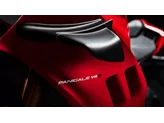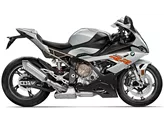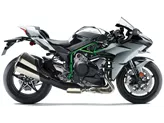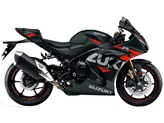Kawasaki Ninja ZX-10R 2016 vs. BMW S 1000 RR 2016

Kawasaki Ninja ZX-10R 2016

BMW S 1000 RR 2016
Vue d’ensemble - Kawasaki Ninja ZX-10R 2016 vs BMW S 1000 RR 2016
The Kawasaki Ninja ZX-10R and the BMW S 1000 RR are both highly regarded supersport motorcycles from the year 2016. While they share many similarities in terms of engine type, displacement, and chassis material, there are also some notable differences that set them apart.
In terms of engine specifications, the Kawasaki Ninja ZX-10R is equipped with a 998cc in-line four-cylinder engine, producing 200.1 horsepower and 114.3 Nm of torque. On the other hand, the BMW S 1000 RR features a slightly larger 999cc in-line four-cylinder engine, delivering 199 horsepower and 113 Nm of torque. Both bikes have a compression ratio of 13 and four cylinders, ensuring a powerful and smooth ride.
When it comes to suspension, the Kawasaki Ninja ZX-10R is equipped with an upside-down telescopic fork at the front and a swing arm at the rear. The BMW S 1000 RR, on the other hand, features a telescopic fork at the front and a swing arm at the rear. While both bikes offer a similar suspension setup, the BMW S 1000 RR is known for its comfortable seating position, allowing riders to enjoy long rides without discomfort.

Kawasaki Ninja ZX-10R 2016
In terms of braking, both motorcycles feature double disk brakes at the front. However, the Kawasaki Ninja ZX-10R utilizes radial and petal technology, which ensures excellent stopping power and heat dissipation. The BMW S 1000 RR, on the other hand, uses radial technology for its front brakes, providing precise and responsive braking performance.
In terms of dimensions and weights, both bikes have a front tire width of 120mm and a rear tire width of 190mm. They also share the same 17-inch front and rear tire diameters. The Kawasaki Ninja ZX-10R has a slightly shorter wheelbase of 1415mm compared to the BMW S 1000 RR's 1425mm. Additionally, the seat height of the Kawasaki Ninja ZX-10R is 813mm, while the BMW S 1000 RR has a seat height of 815mm. Both motorcycles have a fuel tank capacity of 17 liters, allowing for decent range on long rides.

BMW S 1000 RR 2016
In terms of strengths, the Kawasaki Ninja ZX-10R is praised for its great chassis geometry, high-quality chassis components, very good brakes, and extensive electronics. These features contribute to its exceptional handling and performance on the road. On the other hand, the BMW S 1000 RR is known for its very powerful engine, comfortable seating position, and excellent shift assistant, which allows for seamless gear changes.
However, the Kawasaki Ninja ZX-10R does have a weakness in its cockpit, which is not optimally readable. This may cause some inconvenience for riders who rely heavily on the information displayed on the instrument panel. On the other hand, the BMW S 1000 RR has been criticized for being somewhat sluggish in curves, which may affect its overall agility and maneuverability.
In conclusion, both the Kawasaki Ninja ZX-10R and the BMW S 1000 RR are exceptional supersport motorcycles from the year 2016. While the Kawasaki Ninja ZX-10R offers great chassis geometry, high-quality components, and advanced electronics, the BMW S 1000 RR stands out with its powerful engine, comfortable seating position, and smooth gear shifts. Riders looking for a bike with excellent handling and performance may prefer the Kawasaki Ninja ZX-10R, while those seeking a comfortable and powerful ride may lean towards the BMW S 1000 RR.
Caractéristiques techniques Kawasaki Ninja ZX-10R 2016 par rapport à BMW S 1000 RR 2016
Avantages et inconvénients en comparaison
Avantages et inconvénients en comparaison
Kawasaki Ninja ZX-10R 2016

La ZX-10R Ninja a une certaine majesté, lors du premier roulage elle semble très stable, il faut la forcer un peu dans le rayon. Mais après quelques tours, cet effet se transforme en une incroyable précision qui permet de suivre une ligne bien ciblée. Le moteur est maintenant vraiment devenu sensiblement plus puissant et fait de la Kawa un énorme paquet global qui ne peut pas seulement plaire aux fans inconditionnels de Kawasaki. Le contrôle de traction se distingue de manière particulièrement positive sur la Kawa, il régule de manière très sensible. On peut même régler le frein moteur - elle ne manque donc certainement pas de fonctionnalités électroniques. La ZX-10R est la seule Superbike à être compatible avec la norme Euro4 dès 2016 !
BMW S 1000 RR 2016

La S 1000 RR est le talent universel parmi les superbikes - on s'assoit dessus et on se sent tout de suite à l'aise. Même si, en comparaison, elle semble un peu nerveuse en termes de châssis et de stabilité. Mais elle transforme cela en une maniabilité agréable et facile et impressionne par son énorme puissance moteur. La roue avant devient en effet particulièrement légère et doit être calmée par l'amortisseur de direction. L'assistant de changement de vitesse pour monter et descendre les rapports est une fonction incroyablement sportive et confortable - elle apporte du calme au châssis et permet de se concentrer pleinement sur la conduite.
Comparaison des prix Prix moyen du marché Kawasaki Ninja ZX-10R vs BMW S 1000 RR
There are a few key differences between a Kawasaki Ninja ZX-10R 2016 and a BMW S 1000 RR 2016. In terms of price, the actual average price of a Kawasaki Ninja ZX-10R 2016 is about 39% higher. A Kawasaki Ninja ZX-10R 2016 experiences a loss of 1,650 USD in one year and 1,600 USD in two years of ownership. This is offset by a loss of 10 USD and 470 USD for a BMW S 1000 RR 2016. Compared to BMW S 1000 RR 2016 there are less Kawasaki Ninja ZX-10R 2016 bikes available on the 1000PS.de Marketplace, specifically 4 compared to 7. It takes less time to sell a BMW S 1000 RR with 69 days compared to 100 days for the Kawasaki Ninja ZX-10R. Since model year 2005 1000PS.de editors have written 51 reviews for the Kawasaki Ninja ZX-10R and 135 reviews for the BMW S 1000 RR since model year 2010. The first review for the Kawasaki Ninja ZX-10R was published on 1/11/2004 and now has more than 2,900 views. This compares to more than 4,000 views for the first review on BMW S 1000 RR published on 4/16/2008.


















